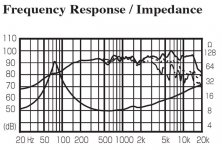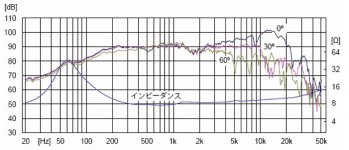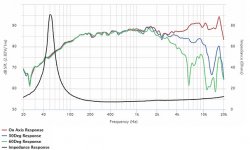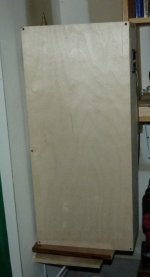After building this kit, I found the FE126En's a little harsh. But I used a solid state amp, not the recommended tube amp. Definately needs bass augmentation.
It was/is an interesting build. The box construction was excellent. This project really teaches the benefits of a point source speaker configuration. I currently favor D'appolito config and my main front speakers in my 5.1 surround system are Inifinity RS5's. I love them, but I did hear more detail in this BK12m kit, at low volume of course. I don't think the Fostek driver is the one for me, despite the high efficiency. I'm going to try Peerless (formerly Vifa) NE123W-08 4" drivers in these boxes next... The on axis frequency response looks really good at the upper frequencies. Anyone try this yet?
It was/is an interesting build. The box construction was excellent. This project really teaches the benefits of a point source speaker configuration. I currently favor D'appolito config and my main front speakers in my 5.1 surround system are Inifinity RS5's. I love them, but I did hear more detail in this BK12m kit, at low volume of course. I don't think the Fostek driver is the one for me, despite the high efficiency. I'm going to try Peerless (formerly Vifa) NE123W-08 4" drivers in these boxes next... The on axis frequency response looks really good at the upper frequencies. Anyone try this yet?
If you can stretch your budget to afford the FE108SOLs (if still available), I'd be surprised if you didn't find them a totally different animal that the 126. Also, don't forget that Scott always tries to optimize a design for the specific driver and any "compromises" the client - Madisound in this case- had in mind.
The BK12 is exactly what it is, and from the several of his designs that I've built/heard, the best of his work for the FE126 would be the Woden Valiant.
The BK12 is exactly what it is, and from the several of his designs that I've built/heard, the best of his work for the FE126 would be the Woden Valiant.
I owned the BK12/FE126en combo a few years ago and also found it to be light in bass, as well. My room is very bass friendly and was only able to muster response down to 60hz.
The FE126en will smooth out a bit as it breaks in, but the peak around 7k needs to be notched out otherwise it's generally unlistenable. After doing so, I found the midrange to be excellent and the top end very decent.
I really enjoyed that kit when I owned it, but wanted to try something new (as this hobby makes you do) and ended up moving on. If it didn't require bass augmentation, it would have been something I could have happily lived with.
The FE126en will smooth out a bit as it breaks in, but the peak around 7k needs to be notched out otherwise it's generally unlistenable. After doing so, I found the midrange to be excellent and the top end very decent.
I really enjoyed that kit when I owned it, but wanted to try something new (as this hobby makes you do) and ended up moving on. If it didn't require bass augmentation, it would have been something I could have happily lived with.
If you can stretch your budget to afford the FE108SOLs (if still available), I'd be surprised if you didn't find them a totally different animal that the 126. Also, don't forget that Scott always tries to optimize a design for the specific driver and any "compromises" the client - Madisound in this case- had in mind.
The BK12 is exactly what it is, and from the several of his designs that I've built/heard, the best of his work for the FE126 would be the Woden Valiant.
I agree with Chris - the FE108Sol looks like a mighty fine driver with nearly flat response out to 10khz at 30 degrees off-axis. Very similar, but smoother, general response compared to the FE103Sol - I own them and they are one of my favorite full range drivers.
Would certainly speed things up, but I thought they were CNC'd for ease of assembly with just glue and clamps/weights - and unless you're subjecting them to far more physical abuse than just listening, keep in mind the FE126, or FE108SOL for those inclined are fairly light duty drivers.
Screws?
I was thinking of the ease of making changes and not having to buy a lot of pipe clamps. Once glued it is forever, whether it is right or wrong
Has anyone used screws to build a Madisound BK12m?
I was thinking of the ease of making changes and not having to buy a lot of pipe clamps. Once glued it is forever, whether it is right or wrong
Has anyone used screw to build a Madisound BK12m?
I have assembled my pair using 5 wood screws per side of each box. I did this because I wanted to be able to disassemble the boxes for future modification. Use pilot holes so you don't split the birch panels.
Attachments
The appeal for me getting this kit was to have a speaker with 1 driver that could go from 100-200Hz all the way up to 20kHz. This avoids crossovers necessary for multiple frequency drivers. Screws up the phasing at critical frequencies for the human ear.I've thought about this kit off and on but the lack of low end presence has kept me from pulling the trigger.
Also, the fun (for me at least) is in the modifications in order to get the optimal sound for the room they're used in.
I've thought about this kit off and on but the lack of low end presence has kept me from pulling the trigger.
If you want good low end response, I would take a good look at the FH3. I get solid response into the 30s with the A7 FH3 combo.
No rattling noticed. Not surprised as these are not high power drivers moving alot of air at low freq's. Also, I did not use the provided padding... I would like to purchase an audio spectrum analyzer first, before any mods. So I can have a quantitative comparison between all modifications.
If you want good low end response, I would take a good look at the FH3. I get solid response into the 30s with the A7 FH3 combo.
While I am involved with the commercial production of kits for these, and my reply could be taken as self-serving, I couldn't agree more as to the performance.
However, for numerous reasons, the P10 kits are currently not available, and even when they are, it's at a much higher price. Further, the BK12's forward firing mouth could be a substantial advantage in terms of placement for many folks.
To repeat an earlier post, while I've not heard the FE108SOL in any enclosure, I'd posit they'd be worth every penny of the extra $118/pr over the FE126, which I agree with those who've remarked finding them a bit harsh and forward in the 5-8k? range.
...To repeat an earlier post, while I've not heard the FE108SOL in any enclosure, I'd posit they'd be worth every penny of the extra $118/pr over the FE126, which I agree with those who've remarked finding them a bit harsh and forward in the 5-8k? range.
The FE108SOL would be my next, and last, driver purchase for this BK12m enclosure, if these Peerless/Vifa FE123W-08 drivers don't live up to expectations. I'm expecting these 4" Peerless drivers in a few days, so I'm anxious for comparison in the same box.
Have you tried any of the spectrum analyzer app on google play?
I did try an Android Audio Spectrum Analyzer app today on my cell phone using the phone's internal mic. I noticed the FFT's fell off very rapidly after 10kHz. That's the crappy mic used in my cell, probably most cell phones. The compression algorithms for audio are meant strictly for voice, i.e. 5KHz and below. So, the cell phone manufacturer chooses an appropriate crappy mic. Some of these cell phone app's do have the ability to receive input from an external 1/8" microphone. But really who is going to sell such a mic? I haven't seen it, yet...
I've actually had my eye on a PC based dedicated spectrum analyzer, with calibrated microphone for $320, 20Hz-20kHz. Product # is the RTA-168B. There is a cheaper RTA-168A, but the -B has calibration data specific to the microphone that was shipped with the product.
cheap fft
Here is a mic
Dayton Audio iMM-6 Calibrated Measurement Microphone for Tablets iPhone iPad and Android
Dayton Audio iMM-6 Calibrated Measurement Microphone for Tablets iPhone iPad and Android
Here is an app
Audio tool
https://play.google.com/store/apps/details?id=com.julian.apps.AudioTool
I ordered the mic and should be able to give a review in a few days.
Here is a mic
Dayton Audio iMM-6 Calibrated Measurement Microphone for Tablets iPhone iPad and Android
Dayton Audio iMM-6 Calibrated Measurement Microphone for Tablets iPhone iPad and Android
Here is an app
Audio tool
https://play.google.com/store/apps/details?id=com.julian.apps.AudioTool
I ordered the mic and should be able to give a review in a few days.
- Home
- Loudspeakers
- Full Range
- Madisound BK12m



